Family name: Orchidaceae Jussieu
Synonym(s): Apostasiaceae Lindl., nom. cons.; Cypripediaceae Lindl.; Limodoraceae Horan.; Neuwiediaceae R. Dahlgren ex Reveal & Hoogland; Vanillaceae Lindl.
Common name(s): orchid family
*Number of genera/species: 736/28,000
List of genera records in GRIN-Global
fruit or seed
Fruit dehiscent, septicidalsepticidal:
type of capsular dehiscence, opening longitudinally by separating between the septa of adjacent carpels
 or loculicidalloculicidal:
or loculicidalloculicidal:
type of capsular dehiscence, opening longitudinally through the locules (compare septicidal)
 capsulecapsule:
capsulecapsule:
a dry, dehiscent fruit formed by two or more carpels
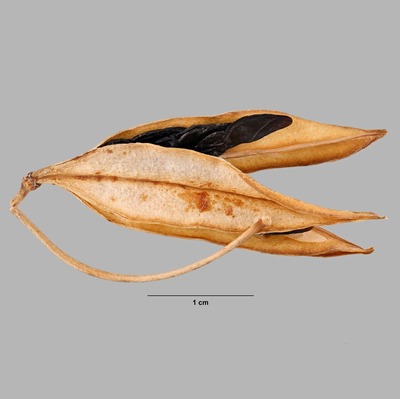 , opening by three or six splits, rarely indehiscentindehiscent:
, opening by three or six splits, rarely indehiscentindehiscent:
not opening on its own, as in a fruit
 , berry (species of Vanilla, Galeola, Palmorchis, Rhizanthella), 3–270 mm long, fusiformfusiform:
, berry (species of Vanilla, Galeola, Palmorchis, Rhizanthella), 3–270 mm long, fusiformfusiform:
spindle-shaped; broadest at the middle and tapering at both ends
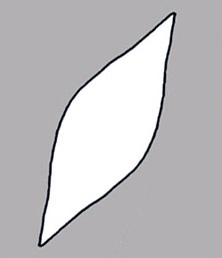 to trigonoustrigonous:
to trigonoustrigonous:
3D shape—having three faces that meet at distinct angles; triangular in outline
, tereteterete:
approximately circular in cross section; width and thickness approximately equal
 or angledangled:
or angledangled:
2D shape—having sides that meet at acute or obtuse angles
in cross section, often sulcatesulcate:
surface relief—having one or more elongate, relatively narrow and shallow depressions or grooves , sometimes winged or beakedbeaked:
, sometimes winged or beakedbeaked:
a usually firm, terminal appendage, sometimes tapered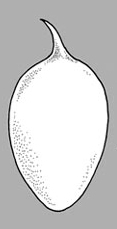 , with a persistent stylestyle:
, with a persistent stylestyle:
in a flower, the narrow and elongated part of the pistil between the stigma and the ovary; sometimes persisting in fruit
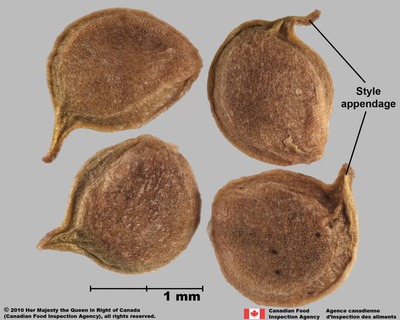 and sometimes with a persistent perianthperianth:
and sometimes with a persistent perianthperianth:
collective term for calyx and corolla of a flower
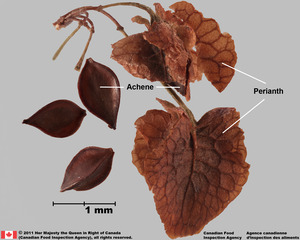 , many seeded. Pericarppericarp:
, many seeded. Pericarppericarp:
fruit wall or fruit coat
white, yellow, brown, black, green, orange, or red, shinyshiny:
uniformly reflecting a high proportion of incident light at all angles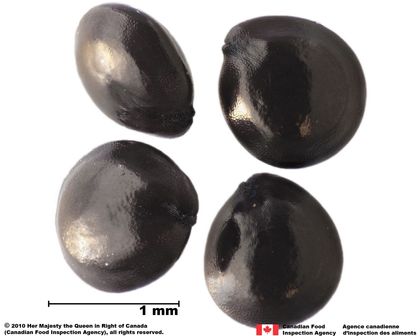 or dulldull:
or dulldull:
reflecting only a low proportion of incident light, with no apparent sheen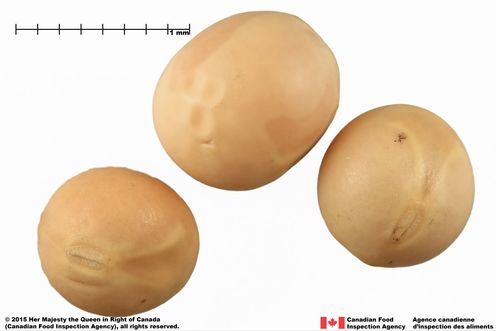 , membranousmembranous:
, membranousmembranous:
texture—extremely thin, pliable, and fairly tough
, crustaceouscrustaceous:
texture—thin, dry, indurate, and brittle
, fleshyfleshy:
texture—fairly firm and dense, juicy or at least moist, and easily cut
, leatheryleathery:
texture—moderately thick, tough, and very pliable
, or woodywoody:
consisting mainly of indurate lignified tissues, characteristic of or resembling wood
, smooth, ribbedribbed:
surface relief—wide, prominent, linear ridges that are generally rounded and longitudinally situated on the surface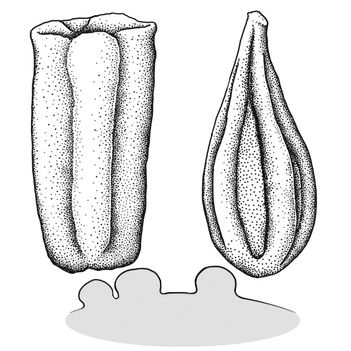 , ridgedridged:
, ridgedridged:
surface relief—raised, thick ridges, sharp edged or rounded, usually in a series that may cover the entire surface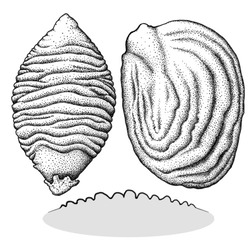 , papillatepapillate:
, papillatepapillate:
surface relief—bearing minute, distinct, broad-based projections, tapering to a rounded apex , scalyscaly:
, scalyscaly:
surface relief—covered with small, thin, fine scales or flakes that may be removable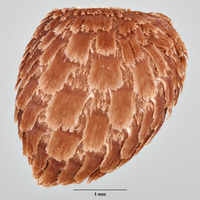 , wartywarty:
, wartywarty:
surface relief—distinct, rounded projections that are large relative to the fruit size; tuberculate, verrucose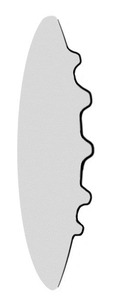 , or spinyspiny:
, or spinyspiny:
having slender, stiff, sharp projections oriented in the general plane of the structure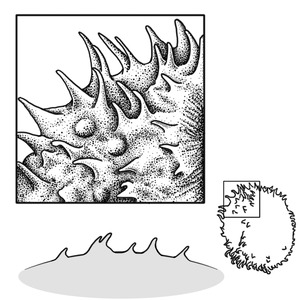 , sometimes pubescentpubescent:
, sometimes pubescentpubescent:
surface relief—bearing hairs
and sometimes with glandularglandular:
surface relief—covered with small, raised secretory glands, regular or irregularly shaped, translucent or opaque, and maybe distinctly colored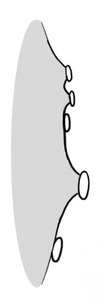 hairs.
hairs.
Seed globoseglobose:
3D shape—more or less spherical
 to fusiformfusiform:
to fusiformfusiform:
spindle-shaped; broadest at the middle and tapering at both ends
 , 0.5–1.4 mm long, with or without caudatecaudate:
, 0.5–1.4 mm long, with or without caudatecaudate:
tapering to a long, tail-like appendage
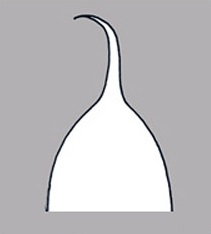 appendage(s). Seed coat brown or black, dulldull:
appendage(s). Seed coat brown or black, dulldull:
reflecting only a low proportion of incident light, with no apparent sheen , loose, hard and thinthin:
, loose, hard and thinthin:
having or being of relatively little depth
, alveolatealveolate:
surface relief—reticulated, honeycombed; ridges that intersect to form polygonal cells with a regular size and shape similar to a honeycomb , reticulatereticulate:
, reticulatereticulate:
surface relief—netted, raised walls or concave grooves forming a net-like surface pattern with flat, concave, or convex interspaces , wartywarty:
, wartywarty:
surface relief—distinct, rounded projections that are large relative to the fruit size; tuberculate, verrucose , pittedpitted:
, pittedpitted:
surface relief—surface with small depressions in which the areas between the hollows do not take on the appearance of a true reticular net or papillatepapillate:
or papillatepapillate:
surface relief—bearing minute, distinct, broad-based projections, tapering to a rounded apex .
.
Embryo rudimentaryrudimentary:
(of embryo) embryo is small and fills less than a quarter of the seed and can be variable in shapes, such as linear, spatulate, or oval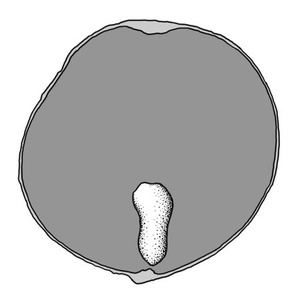 , minute, filling the seed coat, usually chlorophyllous. Endospermendosperm:
, minute, filling the seed coat, usually chlorophyllous. Endospermendosperm:
nutritive starch- and oil-containing tissue present in many seeds
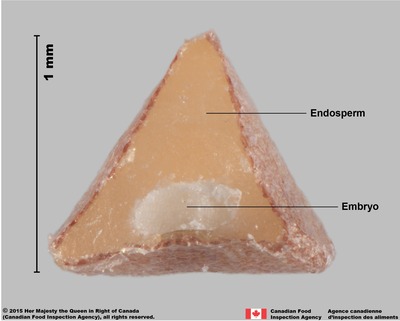 lacking.
lacking.
| Fruit | |
| Type | capsule, rarely berry |
| Size range | 3–270 mm long |
| Shape(s) | ellipsoid, oblongoblong: 2D shape—much longer than broad with nearly parallel sides, corners are rounded  , fusiformfusiform: , fusiformfusiform:spindle-shaped; broadest at the middle and tapering at both ends  , cuneiformcuneiform: , cuneiformcuneiform:=wedge-shaped , cylindricalcylindrical: 3D shape—a cylinder, with parallel sides and a circular cross-section; tubular or rod-shaped , trigonoustrigonous: 3D shape—having three faces that meet at distinct angles; triangular in outline , globoseglobose: 3D shape—more or less spherical  , ovoidovoid: , ovoidovoid:3D shape—ovate  , lanceoloidlanceoloid: , lanceoloidlanceoloid:3D shape—lanceolate , conicalconical: 3D shape—cone-shaped, with the point of attachment at the broad end 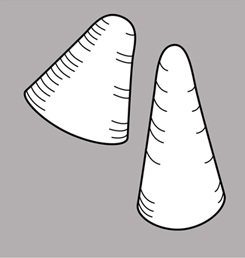 , teardrop-shaped , teardrop-shaped |
| Texture | crustaceous, fleshyfleshy: texture—fairly firm and dense, juicy or at least moist, and easily cut , leatheryleathery: texture—moderately thick, tough, and very pliable , membranousmembranous: texture—extremely thin, pliable, and fairly tough , woody |
| Surface relief | sulcate, smooth, wartywarty: surface relief—distinct, rounded projections that are large relative to the fruit size; tuberculate, verrucose  , ribbedribbed: , ribbedribbed:surface relief—wide, prominent, linear ridges that are generally rounded and longitudinally situated on the surface  , ridgedridged: , ridgedridged:surface relief—raised, thick ridges, sharp edged or rounded, usually in a series that may cover the entire surface  , spinyspiny: , spinyspiny:having slender, stiff, sharp projections oriented in the general plane of the structure  , papillatepapillate: , papillatepapillate:surface relief—bearing minute, distinct, broad-based projections, tapering to a rounded apex  , scaly , scaly |
| Color(s) | white, yellow, brown, black, green, orange, red |
| Unique features | Usually sulcatesulcate: surface relief—having one or more elongate, relatively narrow and shallow depressions or grooves  and/or sculptured capsulescapsules: and/or sculptured capsulescapsules:a dry, dehiscent fruit formed by two or more carpels  , dehiscing by 3 (or 6) hygroscopically sensitive valves, with many dust-like to small seeds. , dehiscing by 3 (or 6) hygroscopically sensitive valves, with many dust-like to small seeds. |
| Seed | |
| Size range | 0.5–1.4 mm long |
| Shape(s) | polygonal, fusiformfusiform: spindle-shaped; broadest at the middle and tapering at both ends  , ovoidovoid: , ovoidovoid:3D shape—ovate  , ellipsoidellipsoid: , ellipsoidellipsoid:3D shape—elliptic , oblongoblong: 2D shape—much longer than broad with nearly parallel sides, corners are rounded  , cylindricalcylindrical: , cylindricalcylindrical:3D shape—a cylinder, with parallel sides and a circular cross-section; tubular or rod-shaped , globoseglobose: 3D shape—more or less spherical  , lens-shaped , lens-shaped |
| Surface relief | alveolate, reticulatereticulate: surface relief—netted, raised walls or concave grooves forming a net-like surface pattern with flat, concave, or convex interspaces  , wartywarty: , wartywarty:surface relief—distinct, rounded projections that are large relative to the fruit size; tuberculate, verrucose  , pittedpitted: , pittedpitted:surface relief—surface with small depressions in which the areas between the hollows do not take on the appearance of a true reticular net  , papillate , papillate |
| Color(s) | brown, black |
| Unique features | Dust-like to small, brown or black, fusiformfusiform: spindle-shaped; broadest at the middle and tapering at both ends  seeds with a loose membranousmembranous: seeds with a loose membranousmembranous:texture—extremely thin, pliable, and fairly tough seed coat sometimes forming an appendage. |
| Other | |
| Embryo | rudimentary, minute, filling the seed coat, usually chlorophyllous |
| Nutritive tissuenutritive tissue: tissue within the seeds that nourishes the developing embryo; such as endosperm, perisperm, or chalazosperm in angiosperms; megagametophyte in gymnosperms |
endosperm endosperm: nutritive starch- and oil-containing tissue present in many seeds  lacking lacking |
Nearly worldwide.
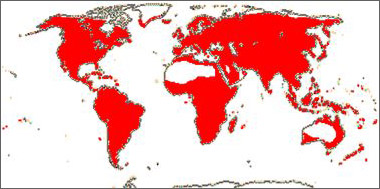
Distribution map courtesy of Angiosperm Phylogeny Website.
Baskin and Baskin 2021Baskin and Baskin 2021:
Baskin C and Baskin J. 2021. Relationship of the lateral embryo (in grasses) to other monocot embryos: A status up-grade. Seed Science Research 31 (3): 199-210. doi:10.1017/S0960258521000209; Dahlgren et al. 1985Dahlgren et al. 1985:
Dahlgren RMT, Clifford HT, and Yeo PF. 1985. The families of the monocotyledons: structure, evolution, and taxonomy. Springer-Verlag, Berlin. 520 pp.; Davidse et al. 2009–2018Davidse et al. 2009–2018:
Davidse GM, Sousa Sánchez M, Knapp S. and Chiang Cabrera F, eds. 2009–2018. Flora Mesoamericana. Missouri Botanical Garden, St. Louis, MO. Accessed: January–April 2024. URL: http://legacy.tropicos.org/Project/FM; Flora of North America Editorial Committee 1993+Flora of North America Editorial Committee 1993+:
Flora of North America Editorial Committee, eds. 1993+. Flora of North America North of Mexico [Online]. 22+ vols. Flora of North America Association, New York and Oxford. Accessed January-March 2024. URL: http://beta.floranorthamerica.org.; Kirkbride et al. 2006Kirkbride et al. 2006:
Kirkbride JH, Jr, Gunn CR, and Dallwitz MJ. 2006. Family guide for fruits and seeds, vers. 1.0. Accessed September 2020-January 2022. URL: https://nt.ars-grin.gov/seedsfruits/keys/frsdfam/index.cfm .; Stevenson and Loconte 1995Stevenson and Loconte 1995:
Stevenson DW and Loconte H. 1995. A cladistic analysis of monocot families. In: Rudall PJ, Cribb PJ, Cutler DF, and Humphries CJ, eds. Monocotyledons: Systematics and Evolution. Royal Botanic Gardens, Kew.; Summerhayes 1968Summerhayes 1968:
Summerhayes VS. 1968. Orchidaceae (Part 1). In: Milne-Redhead E and Polhill RM, eds. Flora of Tropical East Africa. Crown Agents for Oversea Governments and Administrations, London UK. 235 pp.; Takhtajan 1997Takhtajan 1997:
Takhtajan A. 1997. Diversity and Classification of Flowering Plants. Columbia University Press, New York. 643 pp.; Zhengyi et al. 2004+Zhengyi et al. 2004+:
Zhengyi W, Raven PH, and Deyuan H. 2004+. Flora of China [online]. 25 vols. Science Press, Beijing China & Missouri Botanical Garden, St. Louis USA. Accessed January–March 2024. http://flora.huh.harvard.edu/china/
*The number of genera and species is based on Christenhusz and Byng 2016Christenhusz and Byng 2016:
Christenhusz MJM and Byng JW. 2016. The number of known plant species in the world and its annual increase. Phytotaxa 261 (3): 201-217. https://doi.org/10.11646/phytotaxa.261.3.1, which may differ from the number of genera in GRIN-Global.